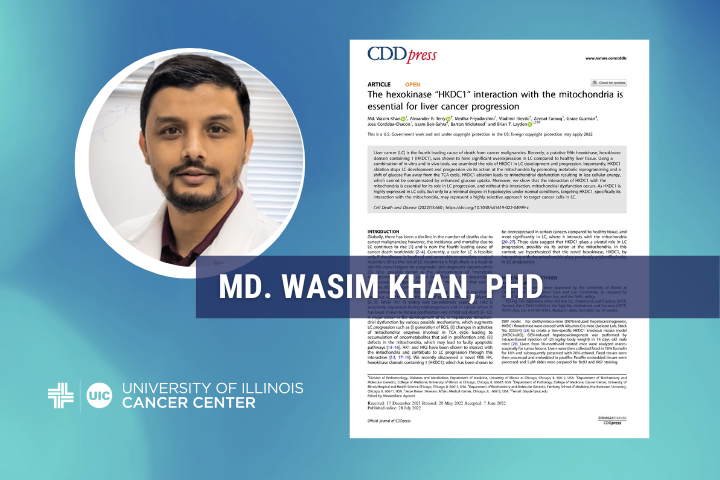
University of Illinois Chicago researchers led by University of Illinois Cancer Center member Wasim Khan have helped discover the role of a previously unknown hexokinase (HK), HKDC1. Their recent work, published in the journal Nature: Cell Death and Disease, shows that HKDC1 is linked to the progression of liver cancer, the fourth leading cause of cancer deaths worldwide.
Traditionally there have been four known HKs, the proteins that help trap glucose in cells where it is further broken down to feed various essential pathways. His research team shows that the fifth HK, HKDC1, is overexpressed in certain cancers compared to healthy tissue.
“Our data suggest that HKDC1 plays a pivotal role in the advancement of liver cancer, possibly via its action at the mitochondria, the cell’s powerhouses,” said Khan, assistant professor at the University of Illinois College of Medicine and a member of the Cancer Center’s Cancer Biology program. “To improve pre-existing therapies and to further develop novel strategies to treat liver cancer, we need to understand the exact molecular mechanisms by which HKDC1 promotes the progression of the disease.”
Through research conducted in both in vitro and animal models, Khan’s group discovered that not only is HKDC1 an essential gene in the progression of liver cancer, it also changes the way cancer cells use glucose.
“As HKDC1 is highly expressed in liver cancer cells – but only to a minimal degree in normal hepatocytes, targeting HKDC1, specifically its interaction with the mitochondria – can be a highly selective approach to target cancer cells,” Khan said.
One in three individuals in the United States is afflicted with metabolic disorders such as hyperglycemia, diabetes, and obesity. These afflictions increase the risk of liver disease, specifically non-alcoholic fatty liver disease (NAFLD). NAFLD encompasses a spectrum of liver anomalies ranging from simple fat accumulation (steatosis) to non-alcoholic steatohepatitis (NASH) to the life-threatening condition of cirrhosis. Cirrhosis can eventually lead to hepatocellular carcinoma (HCC), the most prevalent form of liver cancer.
“Because of its high prevalence and healthcare-related costs, considerable effort is being placed on the design of more effective screening and therapeutic strategies to prevent and reverse NAFLD and stop its progression to HCC,” Khan said. “That’s what we’re trying to do, and we feel our early results are encouraging.”
